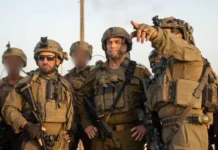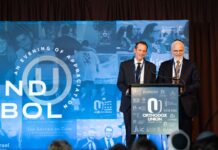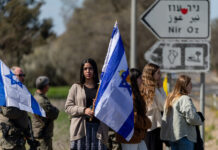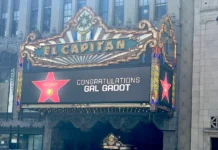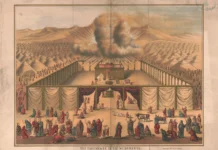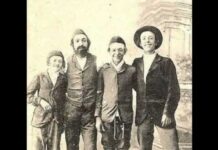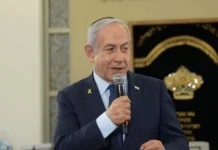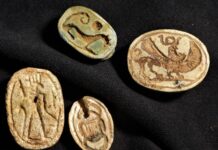Does it always rain on Sukkot, where you live? Here in South Africa, the farmers say as soon as the Jews put up their booths, the rains will come.
Besides the sukkah itself, on this beautiful, joyous festival, we also have the “Four Species”—the lulav, etrog, hadassim and aravot (palm branch, citron, myrtle and willows.) We recite a blessing on them daily, except Shabbat. The etrog is the most expensive by far of these four items. In most communities, you choose and pay for the etrog and the other three come free. Why is this?
There is an interesting teaching that each of the “Four Species” looks like a different part of the body. The tall, straight lulav resembles the spine. The roundish etrog represents the heart. The leaves of the myrtle look like the shape of our eye, and the willow leaves appear like our lips.
Naturally, each of these is very important. We need all four to observe the mitzvah correctly and to recite a blessing on them.
Now, each of these body parts is essential and necessary for our well-being—not only physically but spiritually as well.
A spineless individual is a nobody. Anyone without principles, without the courage of his or her convictions, cannot be a person of worth. “I have my principles,” said one fellow. “But if you don’t like them, no problem. I have others.”
The lips play such a valuable role in our lives. We just observed Yom Kippur, and we recited the “Al Chet” confessional over and over throughout the day. I counted at least nine different sins there all to do with speech. “Lashon hara” (gossiping), bad-mouthing people, speaking foolishly, scoffing, swearing falsely or in vain, and more.
Then there are the eyes. Several of the transgressions in the confessional concern the way we view things and people. Do we have a “begrudging eye?” Do we have a proud, haughty look? Do we look at the wrong things? Do we always look at others critically?
I remember back in my yeshivah days in Montreal, there was an older man in the synagogue, which was in the same building as the school. Somehow, he always complained about the students. So, we gave him a nickname; we called him “Left-Eyed Sam.” Why? Because we were always taught to look at people positively and give them the benefit of the doubt. In Chassidic parlance, this is called to look at another with your “right eye.” So, seeing as this gentleman always saw us negatively, we thought the appellation of “Left-Eyed Sam” was quite appropriate.
But while the spine, lips and eyes are very significant, the heart—represented by the etrog—is indispensable. We can live with back problems, we can survive with speech or vision problems, but without a heart, we’re out of business. No heart means no life.
May I suggest that one significant message from the “Four Species” of Sukkot is that we Jews, in particular, need a heart. A Jewish heart. A heart that pumps, and is vital and full of Jewish vigor. A heart that feels, and is warm and compassionate.
We have been described as “merciful and children of the merciful.” Compassion is in our DNA. If someone behaves sadistically, we might want to check out their Jewish credentials. Before Rosh Hashanah and Passover, I always do a Yom Tov appeal to assist needy families in our community, and a very generous response from the congregation always follows. We are thus able to help dozens of families enjoy a happier holiday. Compassion and charity are in our Jewish blood. And it is the same in every Jewish community around the world.
Let me share a story I told in my shul in Johannesburg before Yizkor on Yom Kippur. I heard it in the name of an eyewitness.
Tragically, one of our brave soldiers lost his life when entering a booby-trapped house in Gaza. After his death, his father was seen frantically searching for his son’s phone.
When they asked him why it was so important, he said he didn’t have any pictures of his son that he could use for the media, who were asking him for a photo. In all the photos he has, his son is bare-chested and full of tattoos. His son was, apparently, quite a wild, rough young man. The father was looking for his son’s phone, hoping to find a photo of him wearing a shirt and looking more respectable.
Later, at the funeral, a religious soldier asked for permission to speak at the service. The family didn’t know him but allowed him to speak out of curiosity.
This religious soldier then stands up at the funeral and tells them the story of how this young man died.
“In Gaza, when the chayalim enter buildings, the Israel Defense Forces policy is that there must always be two soldiers who work together. And they take turns being the first one to enter the building. Because if it is booby-trapped, the first one in will most likely be killed. So, to make it fair, they alternate.
“I was his partner in entering the houses in Gaza. We always took turns going in first, as is the policy. When it came to this particular house the other day, it was my turn to go in first. But my partner here insisted that he should go in first. I said, ‘No. It’s my turn.’
“But he argued with me. He said I have a wife and children, and he is single. And he insisted on going in first. I said it’s my turn, and he said he wanted to go in anyway, and so it went back and forth until he just picked himself up and went in himself.
“And the building was booby-trapped, and that is how he died.”
There at the funeral, with tears streaming down his face, the religious soldier cried out: “He gave his life for me!”
This ruffian, completely tattooed, whose father struggled to find one normal picture of him, became a Kadosh—a holy martyr for his people and his land! This rough and tough young man, who was far from religious and seemingly not all that respectable either, suddenly went from zero to hero! He gave his life for his partner.
Do you understand what a Jewish heart is? What every single Jew is made of? Even the wildest among us is a rough diamond, but a diamond nonetheless.
During the Yom Kippur War, the Lubavitcher Rebbe—Rabbi Menachem M. Schneerson—said that every single soldier in the IDF is a tzaddik gamur, “perfectly righteous.” Anyone who puts on a uniform is putting his life in danger for others, for us. If he or she is prepared to give their lives for our people and our land, how much more righteous can you get? They are the “holy of holies!”
May we all learn from our courageous chayalim, our brave soldiers, whose full-blooded, warm and vital Jewish hearts are there for all to see.
May they be safe, and may we have a heart.
Chag Sameach!




